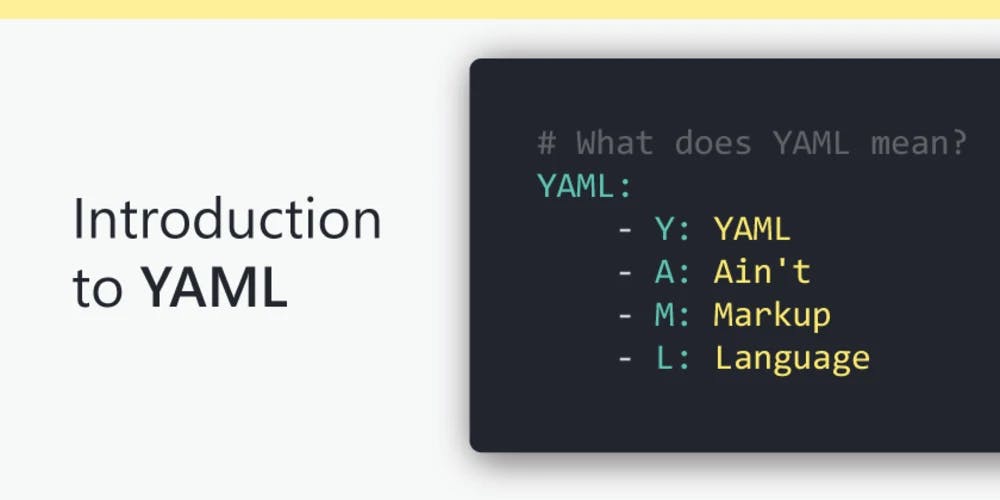Introduction:
In the realm of modern software development, configuration files play a vital role in defining and customizing application behavior. One configuration language that has gained significant popularity in recent years is YAML (YAML Ain't Markup Language). With its intuitive syntax and human-readable structure, YAML offers a simple yet powerful approach to configuring your applications. In this comprehensive blog, we'll dive into the world of YAML, exploring its syntax, features, real-world use cases, best practices, advanced techniques, and ecosystem. Whether you're a seasoned developer or just starting, YAML can revolutionize your configuration management.
Section 1: What is YAML?
YAML serves as a human-readable data serialization format that is both expressive and concise. It provides a clear and straightforward way to represent data structures and configurations. We'll delve into its origins, explaining its design principles and how it differs from other configuration formats like JSON and XML. YAML's key characteristics, such as simplicity, readability, writability, and compatibility with various programming languages, make it a preferred choice for many developers. We'll also discuss YAML's ecosystem, including libraries, tools, and frameworks that support YAML processing, validation, and transformation.
Section 2: YAML Syntax and Structure:

To harness the power of YAML, it's crucial to understand its syntax and structure. We'll explore YAML's indentation-based structure, emphasizing the importance of consistent spacing and hierarchy. YAML supports a wide range of data types, including strings, numbers, booleans, dates, timestamps, and null values. We'll provide examples of these basic data types and demonstrate how they can be nested within lists (arrays) and maps (key-value pairs). Additionally, we'll cover YAML's support for complex data structures, including multidimensional arrays, nested maps, and the use of anchors and aliases for referencing data.
Section 3: YAML in Configuration Files:

Configuration files are at the heart of many applications, frameworks, and tools. YAML's simplicity and readability make it an ideal choice for expressing configurations. We'll delve into real-world examples, showcasing how YAML is used to define database connections, API endpoints, logging settings, application-specific configurations, feature flags, localization, and more. We'll discuss the benefits of using YAML for configuration management, such as easy comprehension, flexibility, version control friendliness, and seamless integration with deployment pipelines and orchestration tools. Furthermore, we'll explore techniques for handling environment-specific configurations, secrets management, and hierarchical configurations with YAML anchors and references.
Section 4: Advanced YAML Features:
While YAML's basic syntax is sufficient for most scenarios, it also offers advanced features that can enhance your configuration files. We'll explore anchors and aliases in-depth, which allow for the reuse and referencing of data within YAML files. This feature can significantly reduce duplication and improve maintainability. We'll also cover YAML's support for custom tags, which enables extending the YAML language with custom data types and processing logic. Additionally, we'll discuss YAML directives for specifying document-wide settings and customization options, including schema validation and custom serialization/deserialization.
Section 5: Best Practices and Tips:

To ensure clean and maintainable YAML code, we'll provide best practices and tips for writing high-quality configurations. We'll cover topics such as using consistent naming conventions, organizing configurations logically, avoiding excessive nesting, employing comments effectively, structuring large YAML files for readability and maintainability, and managing configuration evolution over time. We'll also address potential pitfalls and common mistakes to watch out for when working with YAML, such as indentation errors, quoting pitfalls, type coercion, security considerations, and handling backward compatibility. Additionally, we'll mention popular YAML linters, validators, formatters, and testing frameworks to aid in ensuring the integrity and correctness of your configuration files.
Section 6: Real-World Use Cases:

In this section, we'll explore real-world use cases where YAML shines as a configuration language. We'll showcase how YAML is used in various domains, such as web development, cloud infrastructure provisioning, container orchestration, serverless deployments, continuous integration/continuous deployment (CI/CD) pipelines, and configuration-driven workflows. We'll provide concrete examples and highlight the advantages of using YAML in these scenarios, including readability, maintainability, and ease of collaboration among team members.
Conclusion:
YAML has become an integral part of the software development ecosystem, offering a powerful yet accessible approach to configuration management. By understanding YAML's syntax, structure, advanced features, best practices, and real-world use cases, you can express complex configurations in a concise and human-friendly manner. Whether you're configuring a simple application or managing a large-scale infrastructure, YAML proves to be an invaluable tool in your development arsenal. Embrace YAML and simplify your configuration experience today, while ensuring consistency, maintainability, scalability, and agility in your projects.
Important Note:
While YAML is primarily used for configuration, it's worth mentioning that it has other applications beyond the scope of this blog, such as data serialization, structured document representation, and data exchange formats between different systems. YAML's versatility extends to various domains, making it a valuable asset in your software development toolkit.